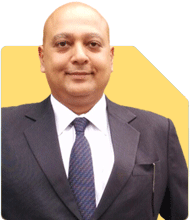35 Lakh Investment: Where to Put My Money?
Ramalingam Kalirajan |7758 Answers |Ask -Follow
Mutual Funds, Financial Planning Expert - Answered on Oct 23, 2024
He has an MBA in finance from the University of Madras and is a certified financial planner.
He is the director and chief financial planner at Holistic Investment, a Chennai-based firm that offers financial planning and wealth management advice.... more

I have Liquid cash of 35 lakhs, wants to know where to invest this amount? (I have 40 Lakhs in MF equity funds, 1.5cr in FD, 50 Lakhs invested in a land and have a house)
Rs. 40 lakhs in equity mutual funds.
Rs. 1.5 crore in fixed deposits.
Rs. 50 lakhs in land.
You also own a house.
Additionally, you now have Rs. 35 lakhs in liquid cash. This offers you flexibility to make new investments, but it’s important to ensure it aligns with your overall financial goals.
Evaluating Your Financial Goals and Risk Appetite
Before deciding where to invest this Rs. 35 lakhs, let’s assess a few things:
Time Horizon: When do you need this money? If it's for a specific purpose like retirement, the investment approach will differ.
Risk Appetite: You have a substantial amount in low-risk assets (fixed deposits). This means you can likely afford some exposure to higher-risk options like equity or hybrid funds.
Liquidity Needs: If you anticipate needing access to this Rs. 35 lakhs in the near term, liquidity should be a priority.
Investment Strategy for Rs. 35 Lakhs
1. Increase Exposure to Equity Mutual Funds
Since you already have Rs. 40 lakhs in equity mutual funds, you understand the value of growth potential in equities. Equity mutual funds can offer high long-term returns, especially when held for 7-10 years or more.
With the current allocation, you could consider investing a portion of the Rs. 35 lakhs into diversified equity mutual funds. However, it is important to ensure that your portfolio is not overly concentrated in a single market sector or type of equity fund. This will give you growth opportunities while balancing risk.
Why Actively Managed Funds?
Higher Return Potential: Actively managed funds aim to outperform the index. This is ideal in fluctuating markets.
Expert Management: You benefit from professional fund managers who make decisions to maximize your returns.
Avoid Index Funds: While index funds track the market, they offer no flexibility. They perform poorly in downturns because they cannot adapt. With actively managed funds, you have a better chance of superior returns.
2. Explore Hybrid or Balanced Funds
Given that you already have significant exposure to both equity (mutual funds) and low-risk (fixed deposits) investments, hybrid or balanced funds can be a good middle-ground. These funds invest in a mix of equity and debt, providing both growth and stability.
Benefit: They offer moderate risk, with the potential for stable growth over a medium-term horizon (5-7 years). You get the security of debt with the growth of equity.
You can allocate a portion of the Rs. 35 lakhs here, aiming for returns that are higher than fixed deposits but with lower risk than pure equity funds.
3. Review Your Fixed Deposits
You have Rs. 1.5 crore in fixed deposits, which offers safety but lower returns. It’s crucial to ask if this much allocation to FDs aligns with your long-term goals.
Reevaluate Fixed Deposit Strategy: Interest rates on fixed deposits are often lower than inflation. This can erode the real value of your wealth. You may want to consider moving some funds from FDs into debt mutual funds or even ultra-short-term funds, which provide better tax efficiency and higher returns than FDs.
4. Invest in Debt Mutual Funds for Stability
For the remaining portion of your Rs. 35 lakhs, consider investing in debt mutual funds. These are less volatile and ideal if you want stable returns.
Advantage: They offer better post-tax returns compared to fixed deposits, especially if held for more than three years.
LTCG Taxation: Debt mutual funds are taxed according to your income tax slab, but the LTCG (long-term capital gains) tax is more favorable than FDs.
5. Avoid Direct Plans Without Professional Guidance
If you are considering direct mutual funds, keep in mind that these are not guided by Certified Financial Planners. Direct plans come with lower costs but lack professional guidance. With regular plans, a Certified Financial Planner helps you make better decisions, optimize returns, and adjust your portfolio when needed.
For someone with a substantial portfolio like yours, it makes sense to work with a professional who can guide you. The value added by a planner often outweighs the marginally higher expense ratio of regular plans.
Addressing Your Current Investments
Equity Mutual Funds: Rs. 40 lakhs is a good allocation, but ensure your funds are well-diversified. Regular reviews are important to avoid over-concentration in specific sectors.
Fixed Deposits: Rs. 1.5 crore is a large sum in FDs. Given current low-interest rates, you may want to move some of this into better-yielding debt funds.
Land Investment: Land is an illiquid investment. It’s great for long-term appreciation, but if you need cash, it might take time to sell. Ensure you don’t rely on this for liquidity.
House: Your house is a non-income generating asset, but it's essential for security and lifestyle.
Understanding Taxation on Investments
Equity Mutual Funds
LTCG (Long-Term Capital Gains): Gains above Rs. 1.25 lakh are taxed at 12.5%.
STCG (Short-Term Capital Gains): Gains are taxed at 20%.
Debt Mutual Funds
LTCG and STCG: Both are taxed as per your income tax slab. But debt mutual funds offer indexation benefits, making them more tax-efficient over the long term.
Final Insights
You have built a strong and diverse portfolio. To enhance it further, consider these key actions:
Allocate a portion of your Rs. 35 lakhs to equity mutual funds for growth, but in an actively managed fund. Avoid index funds, which are too passive and may not give you optimal returns.
Explore hybrid or balanced funds for a mix of growth and stability, especially if you prefer moderate risk.
Reevaluate your fixed deposits. Consider moving some funds to debt mutual funds for better tax efficiency and returns.
Consult with a Certified Financial Planner to ensure your portfolio remains well-balanced, aligned with your goals, and regularly reviewed.
Your financial journey is on the right track. With careful planning and the right investment strategy, you can further enhance your wealth while managing risks.
Best Regards,
K. Ramalingam, MBA, CFP,
Chief Financial Planner,
www.holisticinvestment.in
https://www.youtube.com/@HolisticInvestment
You may like to see similar questions and answers below
Ramalingam Kalirajan |7758 Answers |Ask -Follow
Mutual Funds, Financial Planning Expert - Answered on May 23, 2024
Ramalingam Kalirajan |7758 Answers |Ask -Follow
Mutual Funds, Financial Planning Expert - Answered on Jun 28, 2024
Rajesh Kumar Singh |47 Answers |Ask -Follow
IIT-JEE, GATE Expert - Answered on Feb 01, 2025
Dr Nagarajan Jsk |224 Answers |Ask -Follow
NEET, Medical, Pharmacy Careers - Answered on Feb 01, 2025
Dr Nagarajan Jsk |224 Answers |Ask -Follow
NEET, Medical, Pharmacy Careers - Answered on Feb 01, 2025
Radheshyam Zanwar |1168 Answers |Ask -Follow
MHT-CET, IIT-JEE, NEET-UG Expert - Answered on Feb 01, 2025
Sushil Sukhwani |576 Answers |Ask -Follow
Study Abroad Expert - Answered on Feb 01, 2025
Sushil Sukhwani |576 Answers |Ask -Follow
Study Abroad Expert - Answered on Feb 01, 2025
Sushil Sukhwani |576 Answers |Ask -Follow
Study Abroad Expert - Answered on Feb 01, 2025
Anil Rego |384 Answers |Ask -Follow
Financial Planner - Answered on Feb 01, 2025
Anil Rego |384 Answers |Ask -Follow
Financial Planner - Answered on Feb 01, 2025
Anil Rego |384 Answers |Ask -Follow
Financial Planner - Answered on Feb 01, 2025






















